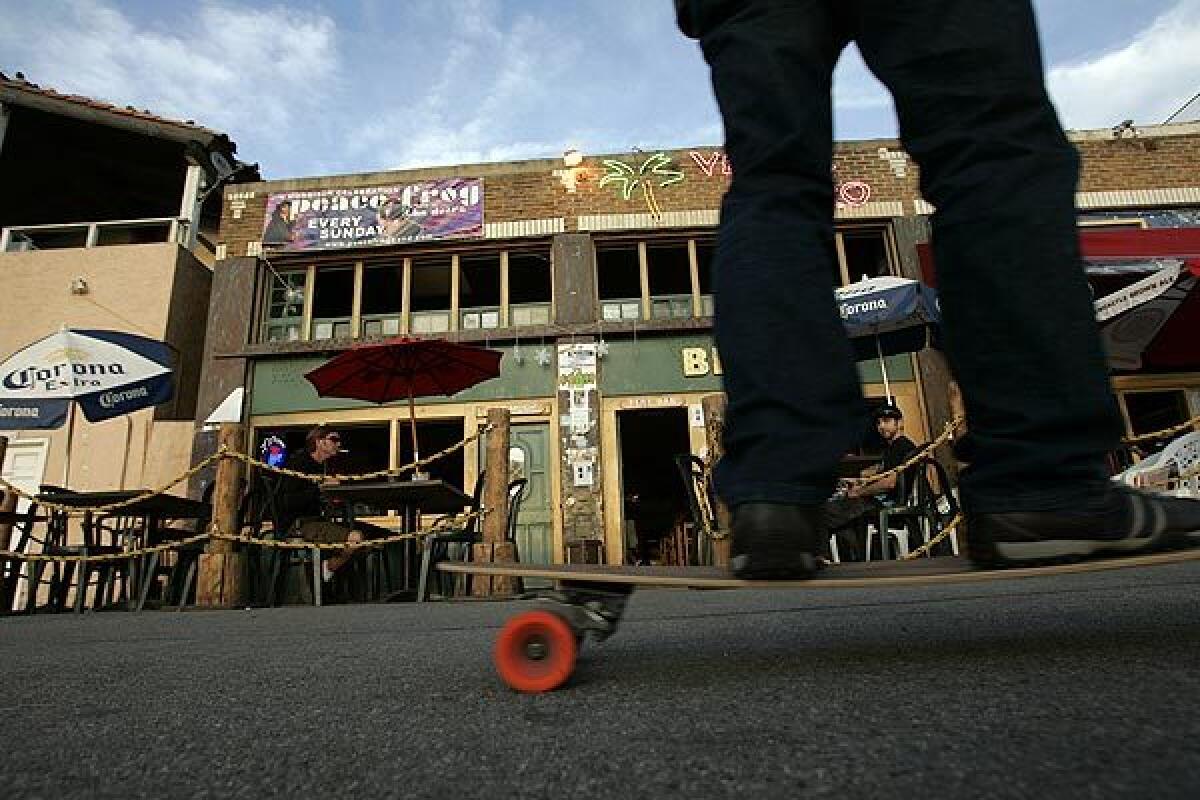Seeking Establishment recognition of Beat hangout’s importance

From 1958 to 1966, the Venice West Cafe served as a gathering place for disciples of Jack Kerouac, Allen Ginsberg and the other pioneers of the Beat Generation who planted the seeds of L.A.’s counterculture movement.
Ray Manzarek, keyboardist for the Doors, recalls the spot as a hangout for post-beatnik intellectuals in dark turtlenecks and jeans, where he and bandmate Jim Morrison, under the influence of LSD, drank espresso and ate croissants while reading Camus and Sartre.
FOR THE RECORD:
Venice West Cafe: An article in Thursday’s Section A about an effort to designate as a landmark the site of the Venice West Cafe, a hangout for Beat Generation poets and artists from 1958 to 1966, said author Lawrence Lipton rued the cafe’s passing in a 1965 Los Angeles Times article. Lipton rued the passing of the counterculture scene generally, not the passing of the cafe, which closed in 1966. —
Although the style of the building on Dudley Avenue near Ocean Front Walk is listed as “commercial vernacular” and nobody seems to know who designed it, the Los Angeles Cultural Heritage Commission is expected to decide today whether to recommend that the site be designated as a city historic-cultural monument.
The low-slung building holds great value as a local symbol of the bohemian spirit of the mid-20th century, says Alan Leib, chairman emeritus of the Los Angeles Conservancy’s Modern Committee.
The city Planning Department’s Office of Historic Resources supports landmarking the site “for its social and cultural significance to the city,” said manager Ken Bernstein. The building’s owners, however, would prefer to avoid the landmark status, fearing it would limit what they could do with the site.
Built in 1922, the flat-roofed structure is rectangular with a slightly rounded corner where Dudley hits the boardwalk and al fresco diners at the Candle Cafe & Grill ingest beer and burgers. The exterior features the original coarse brick, with “steer’s head” ornamentations in white glazed brick accentuating the roofline.
In 1958, poet Stuart Perkoff opened the Venice West Cafe in the building’s abandoned storefront No. 7 “as a place to relax, drink some java and read or listen to poetry and jazz,” according to the monument application submitted by Leib and historic consultant Charles Fisher.
The Beat Generation in Venice had evolved in part in response to disillusionment with the Korean War, particularly among veterans. At 7 Dudley Ave., they found an escape from established norms where they could write and recite poetry, explore jazz and generally avoid what they deemed the soul-stifling workaday existence of their peers. The movement was analogous to the celebrated North Beach Beat scene in San Francisco.
John Haag bought the cafe in 1962 and ran it with his wife, Anna, as a haven for underground artists. Haag, who died in 2006 at 75, co-founded the leftist Peace and Freedom Party in 1967.
Soon after buying the cafe, Haag was arrested for holding poetry readings without a city permit. The case was later thrown out. After the building’s owner attempted to evict the coffeehouse, Haag quietly closed it in 1966.
The structure’s appearance has changed markedly over the years. A lavish, colorful mural adorns the east end. Along Dudley, an erstwhile proprietor added murals with mosaics made of mirror shards.
The building’s uses and tenants also have evolved. A restaurant called 5 Dudley gave way to Piccolo, an upscale eatery that recently expanded into the adjacent portion that had housed Venice West Cafe and, most recently, the Sponto Gallery, a showcase for art, live music and poetry.
Leib envisions eventually closing off the short stretch of Dudley as a pedestrian-friendly zone and creating a bohemian district with brick paving and period lampposts. Ideally, he said, he and others would recreate the Venice West Cafe.
The building’s South Dakota-based owners, whose holdings include Denver’s historic Mayan Theater, are less than enthusiastic about the landmark proposal. “What we like as private owners who take the risk of investing is to retain whatever autonomy we can over our properties,” said James Adelstein, vice president of Northwestern Engineering Co.
Lawrence Lipton, whose 1959 book “The Holy Barbarians” chronicled the Venice counterculture scene, rued the cafe’s passing in a 1965 Los Angeles Times article.
“The Venice West Beat scene was the most promising attempt ever made to bring avant-garde culture to Southern California, and it was murdered by self-righteous, puritanical busybodies and hostile police,” he said.
“We tried to make a Paris-type bohemian community out of the Venice beachfront and scared the wits out of the resident fundamentalists and blue-nosed puritans who make up most of the elderly population of Venice.”
Manzarek, who now writes books and continues to perform music, applauds the vision of a replica Venice West Cafe.
“I think it would be very exciting for today’s young people to have . . . a re-created authentic Beat psychedelic cafe.”
More to Read
Sign up for Essential California
The most important California stories and recommendations in your inbox every morning.
You may occasionally receive promotional content from the Los Angeles Times.











